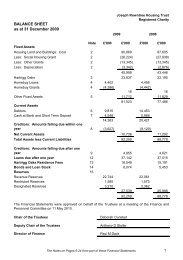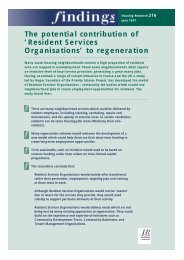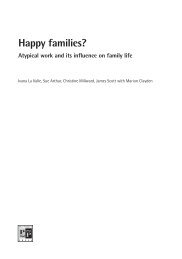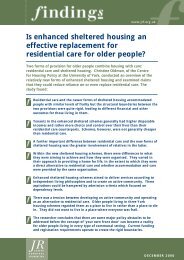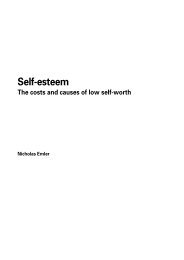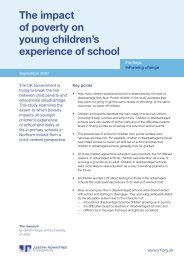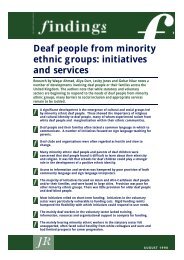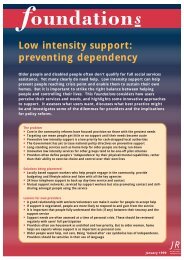Community participation - Joseph Rowntree Foundation
Community participation - Joseph Rowntree Foundation
Community participation - Joseph Rowntree Foundation
You also want an ePaper? Increase the reach of your titles
YUMPU automatically turns print PDFs into web optimized ePapers that Google loves.
Making the most of community <strong>participation</strong>: The 1% Solution<br />
A promising avenue is to recruit a different kind of community elite by backing more<br />
social entrepreneurs to act as the vehicles for local change. One way to do this<br />
would be to replace some community <strong>participation</strong> structures with ‘communityinterest<br />
companies’, run by a social entrepreneur and with local people given<br />
representative rights as ‘shareholders’ in this enterprise rather than as voters or<br />
residents. This shift in emphasis should be mirrored in a shift in the type of support<br />
offered by the State, with a new focus on the transferral of assets to community<br />
control as a way of giving social enterprises the resources they need to get started,<br />
to secure loans and to provide the basis for lasting financial independence from<br />
Government. 12<br />
Disconnecting and reconnecting the 1 per cent<br />
While it may not be possible to counteract the effects of the network dynamics we<br />
have identified, there are almost certainly opportunities to ‘disconnect’ and<br />
‘reconnect’ community elites and their stakeholders in new ways. Even if we accept<br />
that 1 per cent is the best we can do, we can do more to ensure that a different 1 per<br />
cent matters at different times and places, and that it can be recomposed, refreshed,<br />
recalled and rotated. In the language of Chapter 4, community <strong>participation</strong> must<br />
foster ‘transactions’ that spread social capital and not just ‘investments’ that<br />
concentrate it.<br />
As a first step, local authorities should create directories and knowledge banks about<br />
community <strong>participation</strong> in their area. For local people, this would make a terribly<br />
confusing governance landscape much easier to understand and navigate, and help<br />
them to see how community <strong>participation</strong> in governance can make a practical<br />
difference to their everyday lives. It would tell them who they needed to speak to in<br />
relation to different issues, what powers they had, what resources they might be able<br />
to access, what help they could be and how they themselves could get involved. For<br />
local and national agencies, it would mean that a whole series of more interesting<br />
and more important questions could start to gain traction on policy and practice. Who<br />
are the 1 per cent? What are they like? How diverse/reflective of the population are<br />
they? How are they connected to one another? How have they been recruited? Do<br />
they reflect the diversity of the communities from which they are drawn?<br />
This knowledge would promote transparency and accountability, and assist better<br />
planning and recruitment processes. But mapping these connections and making<br />
them visible would also offer a different, more human gaze on governance, which<br />
could in turn generate ideas about how it might be improved.<br />
55




